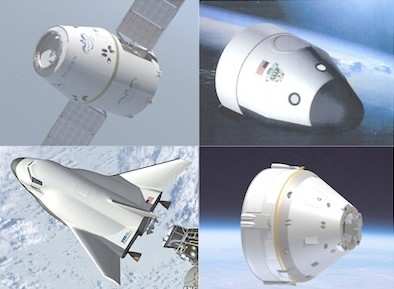Progress Being Made To Return To U.S. Manned Space Launches
Working in wind tunnels, software laboratories and work stations across America, NASA's Commercial Crew Program (CCP) partners continue to make strides in advancing the designs of the American spacecraft and rockets that will carry humans safely and reliably into low-Earth orbit from U.S. soil by 2017.

Blue Origin, The Boeing Company, Sierra Nevada Corporation (SNC) and Space Exploration Technologies (SpaceX) are accomplishing milestones established through Space Act Agreements as part of the agency's Commercial Crew Development Round 2 and Commercial Crew Integrated Capability initiatives.
CCP's engineering team is working closely with its partners as they develop the next generation of crewed spacecraft and work toward challenging evaluations and tests this year. Ultimately, NASA intends to certify and use American-made commercial systems to fly astronauts from U.S. soil to the International Space Station, and back, ending our sole reliance on Russia to get to space.
"What we have seen from our industry partners is a determination to make their components and systems work reliably, and in turn they've been able to demonstrate the complex machinery that makes spaceflight possible will also work as planned," said Kathy Lueders, Commercial Crew Program manager. "These next few months will continue to raise the bar for achievement by our partners."
Boeing completed its most in-depth evaluation in April of the software planned to operate the CST-100 spacecraft. Called a critical design review, or CDR, the evaluation confirmed the computer coding can be used in flight tests. Spacecraft are increasingly dependent on computers that automate systems and perform split-second commands, making the software one of the most crucial elements of the spacecraft.

SNC put models of its Dream Chaser spacecraft through rigorous wind tunnel tests at facilities across America as it refined the design by studying its reaction to subsonic, transonic and supersonic conditions it will encounter during ascent into space and re-entry from low-Earth orbit. Several Dream Chaser scale model spacecraft were subjected to multiple wind tunnel tests in various configurations, including the integrated launch stack of Dream Chaser on a United Launch Alliance Atlas V rocket.
SpaceX conducted an integrated critical design review in April of major hardware and software elements of the company's Dragon spacecraft and Falcon 9 rocket. The critical design review took into account a host of previous reviews of the design of the vehicles along with the testing involved in verifying the systems.
As in building a house or other complex structure, these advancements set the stage for upcoming accomplishments on the path to a completed space transportation system. Blue Origin is closing in on an interim design review for the subsystems of its Space Vehicle design, a biconic spacecraft the company is developing to carry humans into low-Earth orbit.
Boeing will complete a critical design review that will cover all elements of the crewed spacecraft, rocket, as well as ground and mission operations in the coming months.
SNC is preparing to share its results from a series of tests of the reaction control system motors for the Dream Chaser spacecraft at a subcontractor facility, and main engine motor tests at SNC's Poway, California, facility.
SpaceX continues to develop hardware for a series of flight tests later this year that will put the Dragon's launch abort system through simulated emergencies to make sure it will perform for astronauts in the unlikely event of a mishap during launch or ascent into orbit.
Milestones achieved by CCP's partners continue to advance commercial spacecraft and transportation systems from design to reality. The successes of NASA and American aerospace companies are ushering in a new generation of space transportation capabilities, which will enable new opportunities for humans to live and work in space.
 ANN's Daily Aero-Term (04.26.24): DETRESFA (Distress Phrase)
ANN's Daily Aero-Term (04.26.24): DETRESFA (Distress Phrase) ANN's Daily Aero-Linx (04.26.24)
ANN's Daily Aero-Linx (04.26.24) Airborne 04.22.24: Rotor X Worsens, Airport Fees 4 FNB?, USMC Drone Pilot
Airborne 04.22.24: Rotor X Worsens, Airport Fees 4 FNB?, USMC Drone Pilot Airborne 04.24.24: INTEGRAL E, Elixir USA, M700 RVSM
Airborne 04.24.24: INTEGRAL E, Elixir USA, M700 RVSM Airborne-NextGen 04.23.24: UAVOS UVH 170, magni650 Engine, World eVTOL Directory
Airborne-NextGen 04.23.24: UAVOS UVH 170, magni650 Engine, World eVTOL Directory




